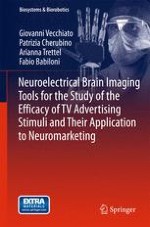In this book the authors describe their original research on the potential of both standard and high-resolution electroencephalography (EEG) for analyzing brain activity in response to TV advertising. When engineering techniques, neuroscience concepts and marketing stimuli converge in one research field, known as neuromarketing, various theoretical and practical aspects need to be considered. The book introduces and discusses those aspects in detail, while showing several experiments performed by the authors during their attempts to measure both the cognitive activity and emotional involvement of the test subjects. In these experiments, the authors apply simultaneous EEG, galvanic skin response and heart rate monitoring, and show how significant variations of these variables can be associated with attention to, memorization or enjoyment of the presented stimuli. In particular, this book shows the central role of statistical analysis in recovering significant information on the scalp and cortical areas involved, along with variations of activity in the autonomous nervous system. From an economic and marketing perspective, the aim of this work is to promote a better understanding of how mass consumer advertising of (established) brands affects brain systems. From a neuroscience perspective, the broader goal is to provide a better understanding of both the neural mechanisms underlying the impact of affect and cognition on memory, and the neural correlates of choice and decision-making.
=> Please download the extra material for this book http://extras.springer.com
